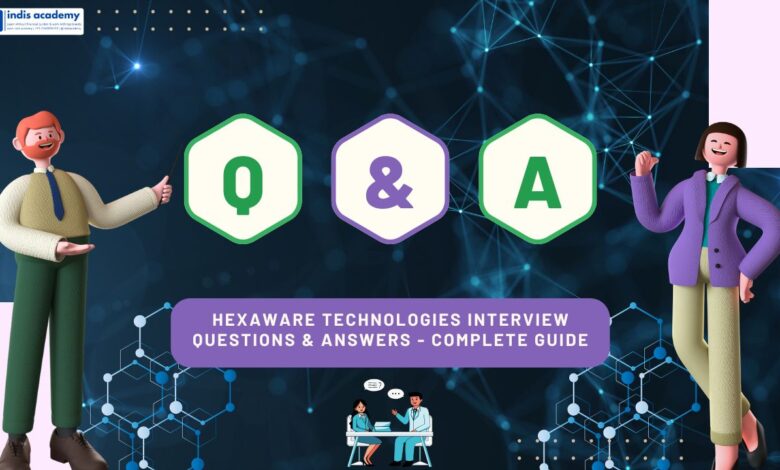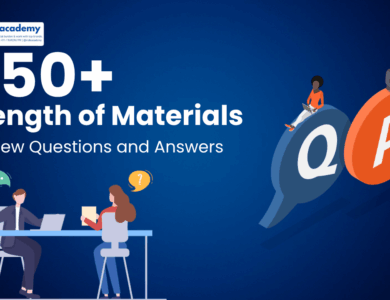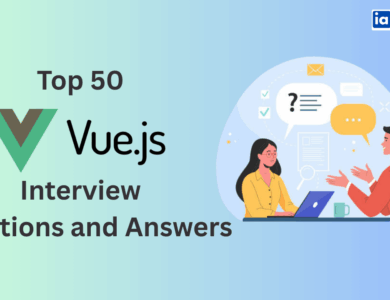Hexaware Technologies Interview Questions & Answers – Complete Guide
Prepare for your Hexaware interview with our handpicked list of top 50 interview questions, answers, tips, and real insights. Perfect for freshers and experienced candidates.

Are you preparing for an interview at Hexaware Technologies and feeling unsure about where to start? Don’t worry—you’re not alone. With its growing presence in IT services and business process outsourcing, Hexaware has become a preferred employer for both freshers and experienced professionals across India.
Whether you’re applying for a role in software development, testing, support, or data analytics, understanding the interview pattern and preparing for the right set of questions can make all the difference between getting shortlisted or not.
This guide is your one-stop solution to crack the Hexaware interview—we’ve compiled the most commonly asked questions, along with expert tips, real interview feedback, and role-specific advice to help you feel fully prepared.
From technical rounds to HR interviews, from coding tests to behavioral questions, this blog has everything you need to clear each round with confidence and leave a lasting impression.
Let’s dive right into the process and questions so you can step into your interview well-prepared and stress-free!
Explore more
- Top 50 HTML & CSS Interview Questions and Answers
- Top Functional Testing Interview Questions and Answers – Crack Your QA Interview with Confidence
Interview Process at Hexaware Technologies
Before jumping into the actual questions, it’s important to understand the interview structure at Hexaware Technologies. Knowing what to expect in each round helps you prepare better, manage your time, and reduce anxiety on the big day.
Here’s a typical breakdown of the Hexaware interview process, especially for freshers and entry-to-mid level experienced candidates:
🔹 1. Online Assessment (Aptitude + Technical)
This is usually the first filtering round, often conducted on platforms like AMCAT, CoCubes, or HackerRank.
You can expect:
- Quantitative aptitude & logical reasoning
- Basic programming questions (C, C++, Java, Python, etc.)
- Code debugging or output-based MCQs
- Time-bound test (60–90 minutes)
📝 Tip: Practice questions on topics like time & work, number series, basic loops, arrays, and functions.
🔹 2. Technical Interview
If you clear the assessment, you’ll be called for a face-to-face or virtual technical interview.
Here’s what this round usually focuses on:
- Your core technical knowledge (based on your resume)
- OOPs concepts, DBMS, Operating Systems, Data Structures
- Programming/coding logic (live problem solving or whiteboard coding)
- Questions about your academic or personal projects
- Sometimes puzzles or situational logic questions
📝 Tip: Be ready to explain every line of your project and any technology mentioned in your resume.
3. HR / Managerial Interview
This is the final round and is more of a personality and culture fit check.
It can include:
- Behavioral questions (Tell me about yourself, strengths, weaknesses)
- Questions about relocation, work shifts, salary expectations
- Managerial questions (How do you handle deadlines, team conflicts, multitasking?)
📝 Tip: Stay confident, be honest, and align your answers with the company’s values and job description.
💡 Additional Notes:
-
For experienced candidates, there may be 2+ technical rounds, including system design or domain-specific assessments.
-
Some profiles (like testing, DevOps, or support roles) may include practical assignments or remote task evaluations.
Understanding this structure gives you a clear game plan. Now that you know the path ahead, let’s move on to the actual interview questions and answers you should prepare for.
Top Hexaware Technologies Interview Questions & Answers
Q1. Tell me about yourself.
Answer:
Start with your name, educational background, any internships or projects you’ve worked on, and your technical strengths. Keep it concise and tailored to the job role.
🗣 Example:
“I’m Priya Singh, a Computer Science graduate from XYZ University. During my final year, I developed a web-based attendance management system using PHP and MySQL. I’m skilled in Java, SQL, and I enjoy problem-solving. I’m looking for a platform like Hexaware to kickstart my career and grow in the software development domain.”
Q2. What is Object-Oriented Programming (OOP)?
Answer:
OOP is a programming paradigm based on the concept of “objects”, which can contain data and code. The four main pillars of OOP are:
- Encapsulation
- Inheritance
- Polymorphism
- Abstraction
🗣 Example:
“In Java, OOP helps in building modular code. For example, if I create a class Car, it can have attributes like color, speed, and methods like drive(), brake(). This makes code reusable and easier to manage.”
Q3. What is the difference between Java and C++?
Answer:
- Java is platform-independent (runs on JVM), whereas C++ is platform-dependent.
- Java has automatic garbage collection; C++ does not.
- C++ supports both procedural and OOP paradigms; Java is purely OOP.
🗣 Tip: Highlight which one you are more comfortable with and why.
Q4. What is normalization in DBMS?
Answer:
Normalization is a process to minimize redundancy and dependency in a database by organizing data into related tables.
- 1NF: Removes repeating groups
- 2NF: Removes partial dependencies
- 3NF: Removes transitive dependencies
🗣 Example:
“During my final project, I normalized my database to 3NF to ensure data integrity and improve query efficiency.”
Q5. Write a SQL query to fetch the second highest salary from an Employee table.
Answer:
SELECT MAX(salary) FROM employees WHERE salary < (SELECT MAX(salary) FROM employees);
🗣 Tip: Be ready to explain how nested queries work.
Q6. Explain the difference between clustered and non-clustered indexes.
Answer:
- Clustered Index: Alters the physical order of the table and there can be only one per table.
- Non-Clustered Index: Doesn’t change the physical order and there can be many.
🗣 Example:
“In a large employee table, I used a non-clustered index on the ’email’ column to speed up lookups without affecting the table’s structure.”
Q7. What are your strengths and weaknesses?
Answer:
Be honest but strategic.
🗣 Example:
“My strength is my ability to adapt and learn quickly, especially with new technologies. One area I’m working on is public speaking, and I’ve started participating in college meetups to improve.”
Q8. What is SDLC and its phases?
Answer:
SDLC (Software Development Life Cycle) is a process used to design, develop, and test software. The phases include:
- Requirement Gathering
- Design
- Development
- Testing
- Deployment
- Maintenance
🗣 Tip: Mention which phase you’ve been exposed to in your project or internship.
Q9. Explain your final year project in detail.
Answer:
Give a short summary: problem statement, tech stack, your role, and the outcome.
🗣 Example:
“My project was a food delivery app built using React Native and Firebase. I worked on the real-time order tracking and payment integration modules. We tested it on a group of students, and it handled 100+ orders with no major bugs.”
Q10. What is a primary key and a foreign key?
Answer:
- Primary Key: Uniquely identifies each record in a table.
- Foreign Key: Links one table to another by referencing the primary key of another table.
🗣 Example:
“In an orders table, customer_id can be a foreign key referencing the customers table’s primary key.”
Hexaware Technologies Interview Questions for Coding, Problem Solving & Technical Logic (Freshers + Experienced)
Q11. Write a program to reverse a string without using in-built functions.
Answer (in Java):
String input = "Hexaware";
String reversed = "";
for(int i = input.length() - 1; i >= 0; i--) {
reversed += input.charAt(i);
}
System.out.println(reversed); // Output: erawaxeH
🗣 Tip: Know how to reverse strings using loop or recursion in your preferred language.
Q12. Explain the difference between GET and POST methods in HTTP.
Answer:
- GET: Sends data via URL; visible to users; limited in size; used for fetching.
- POST: Sends data in the request body; secure; used for submitting forms.
🗣 Example:
“In my web project, I used GET for search filters and POST for user registration.”
Q13. What is the difference between an interface and an abstract class in Java?
Answer:
- Interface: All methods are abstract by default (till Java 7); supports multiple inheritance.
- Abstract class: Can have both abstract and non-abstract methods; cannot be instantiated.
🗣 Tip: Give a use-case where you chose abstract class over interface (or vice versa).
Q14. What is a deadlock in operating systems?
Answer:
Deadlock is a situation where two or more processes are waiting for each other to release resources, and none can proceed.
🗣 Example:
“In multithreading, if Thread A holds Lock 1 and waits for Lock 2 while Thread B holds Lock 2 and waits for Lock 1, a deadlock occurs.”
Q15. Write a program to check if a number is a palindrome.
Answer (in Python):
num = 121
if str(num) == str(num)[::-1]:
print("Palindrome")
else:
print("Not a Palindrome")
🗣 Tip: Know logic for palindrome, prime, factorial, Fibonacci, etc.
Q16. What are access specifiers in Java?
Answer:
Java has four access specifiers:
- public – accessible everywhere
- private – accessible only within the class
- protected – accessible within package and subclass
- default – accessible only within package
🗣 Tip: Use examples to demonstrate understanding of scope.
Q17. What is recursion? Provide an example.
Answer:
Recursion is when a function calls itself to solve a problem.
Example: Factorial (in C++)
int factorial(int n) {
if(n <= 1) return 1;
return n * factorial(n - 1);
}
Q18. What is the difference between ArrayList and LinkedList in Java?
Answer:
- ArrayList: Fast in searching; slow in insertion/deletion
- LinkedList: Fast in insertion/deletion; slow in searching
Both implement the List interface.
🗣 Tip: Mention which one you’d use in what scenario.
Q19. What is the difference between == and .equals() in Java?
Answer:
==compares object references (memory addresses).equals()compares the values/content of objects
🗣 Example:
If str1 = new String("Hexaware") and str2 = new String("Hexaware"), then:
str1 == str2→ falsestr1.equals(str2)→ true
Q20. Explain join operations in SQL.
Answer:
- INNER JOIN: Returns records that have matching values in both tables
- LEFT JOIN: All records from the left table, and matched records from the right
- RIGHT JOIN: All from the right table, matched from the left
- FULL JOIN: All records when there is a match in either table
🗣 Tip: Practice real JOIN-based queries on dummy tables like employees & departments.
Q21. What is ACID property in a database?
Answer:
ACID stands for:
- Atomicity: Transactions are all or nothing
- Consistency: Data remains valid before and after transaction
- Isolation: Concurrent transactions don’t affect each other
- Durability: Once committed, changes persist even after system failures
🗣 Tip: Explain with example: online banking transactions.
Q22. What is the difference between DELETE, TRUNCATE, and DROP?
Answer:
- DELETE: Removes rows one by one; can be rolled back
- TRUNCATE: Removes all rows instantly; can’t be rolled back
- DROP: Deletes entire table structure
🗣 Example:
“I use DELETE when I need to remove selective records, TRUNCATE for clearing logs.”
Q23. What are stored procedures?
Answer:
Stored procedures are precompiled SQL queries stored in the database. They improve performance and reusability.
🗣 Example:
“I created a stored procedure to fetch employee salary data based on departments, which helped reduce query time by 30%.”
Q24. Explain normalization vs denormalization.
Answer:
- Normalization: Organizing data to reduce redundancy (ideal for OLTP systems)
- Denormalization: Combining tables for faster reads (ideal for OLAP systems)
🗣 Tip: Use e-commerce or banking schema as examples.
Q25. What is a composite key?
Answer:
A composite key is a combination of two or more columns that uniquely identify a record.
🗣 Example:
“In an orders table, order_id + product_id can be a composite key.”
Q26. Write a SQL query to fetch duplicate records from a table.
Answer:
SELECT column_name, COUNT(*) FROM table_name GROUP BY column_name HAVING COUNT(*) > 1;
🗣 Tip: Mention handling duplicates using DISTINCT, ROW_NUMBER() too.
Q27. What is indexing in a database?
Answer:
Indexing helps speed up data retrieval.
Types:
- Primary index
- Unique index
- Composite index
- Full-text index
🗣 Example:
“I added indexes on the ‘email’ field in a user table to improve login performance.”
Q28. What is the difference between OLTP and OLAP?
Answer:
- OLTP: Online Transaction Processing (fast inserts/updates) – e.g., banking system
- OLAP: Online Analytical Processing (complex queries/reports) – e.g., data warehouses
Q29. Explain CAP Theorem.
Answer:
CAP stands for:
- Consistency: All nodes see the same data at the same time
- Availability: Every request gets a response
- Partition Tolerance: System continues despite network failures
🗣 Tip: In distributed systems, you can only achieve two of the three at any time.
Q30. How would you design a scalable URL shortening service like Bitly?
Answer:
Key points to cover:
- Unique ID generation (Base62, hash, counter)
- Redirection logic and expiry handling
- Database sharding
- Caching with Redis or Memcached
- Monitoring and load balancing
🗣 Bonus: “I’d also implement analytics tracking and rate limiting to prevent abuse.”
Hexaware Technologies Interview Questions HR, Behavioral & Situational Questions
Q31. Why do you want to join Hexaware Technologies?
Answer:
“Hexaware stands out as a company that emphasizes innovation, learning, and employee well-being. I’m impressed by its digital transformation projects and client portfolio. For a fresher like me, it offers the right platform to grow technically and professionally.”
🗣 Tip: Do your research and align your answer with their values.
Q32. Tell me about a time you failed and how you handled it.
Answer:
“In my college project, I misjudged the timeline for API integration and we missed our first internal demo. I took responsibility, worked overnight, and completed the module. It taught me the importance of realistic planning and communication.”
Q33. How do you handle stress and pressure during tight deadlines?
Answer:
“I break tasks into smaller goals and prioritize based on impact. I also maintain a checklist to track progress and stay calm. Taking quick breaks and staying organized really helps me stay focused.”
Q34. Where do you see yourself in 5 years?
Answer:
“I aim to become a subject matter expert and take on leadership responsibilities. I want to continuously upskill, work on impactful projects, and grow within the company.”
Q35. Tell me about a time you worked in a team.
Answer:
“In my final year, we built an attendance system. I handled backend logic while others worked on frontend and testing. We had regular sync-ups and shared feedback. This collaboration helped us finish ahead of time.”
Q36. If your teammate is not contributing, how would you deal with it?
Answer:
“I’d talk to them privately to understand if they’re facing any issues. If it continues, I’d bring it up respectfully in a group meeting or inform the team lead if needed.”
Q37. What motivates you at work?
Answer:
“Learning new things, solving real-world problems, and being recognized for my efforts motivate me. When I see my code or ideas in a live product, it’s deeply satisfying.”
Q38. How do you keep yourself updated with new technologies?
Answer:
“I follow YouTube channels like Telusko, read blogs on GeeksforGeeks, and explore platforms like Udemy and LinkedIn Learning to stay up to date.”
Q39. What is more important to you: Job stability or growth opportunities?
Answer:
“Both matter, but at this stage of my career, growth opportunities are more important. I want to learn, explore new roles, and keep evolving.”
Q40. Do you have any questions for us?
Answer:
Always say yes! Here are a few smart ones:
- “Can you tell me more about the learning and development programs at Hexaware?”
- “What does success look like in the first 6 months for this role?”
- “What kind of projects will I be working on initially?”
Q41. What is the difference between manual and automation testing?
Answer:
- Manual Testing: Performed by a human without tools; suitable for exploratory, ad-hoc testing.
- Automation Testing: Uses tools/scripts to execute tests; best for regression and repeated tests.
🗣 Tip: Mention tools like Selenium, JUnit, or TestNG if you’ve used them.
Q42. Explain the bug life cycle in software testing.
Answer:
- New
- Assigned
- Open
- Fixed
- Retested
- Verified
- Closed or Reopened
🗣 Tip: Share how you logged bugs in tools like Jira or Bugzilla.
Q43. What are test cases and test scenarios?
Answer:
- Test Case: Step-by-step instructions with input, action, and expected output.
- Test Scenario: A broader condition or functionality to be tested.
🗣 Example:
“Test scenario: Login functionality; Test case: Login with valid/invalid credentials.”
Q44. What’s the difference between ETL and ELT in data processing?
Answer:
- ETL: Extract → Transform → Load (used in traditional data warehouses)
- ELT: Extract → Load → Transform (common in big data platforms like Snowflake)
Q45. What is data cleaning? Why is it important in analytics?
Answer:
Data cleaning involves removing inconsistencies, duplicates, and correcting errors in datasets.
🗣 Tip: Clean data ensures accurate reporting and model predictions.
Q46. What is the difference between OLAP cubes and star schema?
Answer:
- OLAP Cube: Multi-dimensional view of data for fast querying.
- Star Schema: Central fact table with dimension tables — used in designing data warehouses.
Q47. Explain the architecture of cloud computing.
Answer:
- Frontend (Client)
- Backend (Servers, storage, applications)
- Cloud services (IaaS, PaaS, SaaS)
🗣 Tip: Mention platforms like AWS, Azure, or GCP if familiar.
Q48. What is virtualization in cloud infrastructure?
Answer:
Virtualization allows multiple virtual machines to run on a single physical machine using a hypervisor. It optimizes resource utilization and flexibility.
Q49. How would you troubleshoot a customer support issue in production?
Answer:
- Listen carefully to the issue
- Reproduce the problem if possible
- Check logs, server metrics, recent changes
- Escalate if needed with proper documentation
🗣 Tip: Mention a real incident where you resolved or supported an issue calmly.
Q50. What scripting languages or automation tools have you used?
Answer:
“I’ve worked with Shell and Python for simple automation scripts, and I’ve used Jenkins for CI/CD pipelines and Selenium for browser automation.”
Tips to Prepare for the Hexaware Interview
Whether you’re a fresher or an experienced professional, cracking a Hexaware interview requires more than just textbook knowledge. Here are some practical, actionable tips to help you stand out:
✅ 1. Understand the Job Role You’re Applying For
Before anything else, study the job description carefully. Know which skills are mandatory, what tools or languages are mentioned, and tailor your preparation accordingly.
🗣 Tip: Mention the skills listed in the JD during your interview—it shows alignment.
✅ 2. Master the Basics First
For technical roles, your foundation in:
- OOPs concepts
- Data Structures & Algorithms
- DBMS & SQL queries
- Basic coding (Java, Python, C++)
…must be solid. Revise concepts using platforms like:
- GeeksforGeeks
- JavaTpoint
- InterviewBit
✅ 3. Practice Coding Under Time Pressure
The first round often has online assessments. Practice coding on:
- HackerRank
- CodeChef
- LeetCode (Easy to Medium problems)
Try to solve problems in 20–30 minutes and focus on logic, not just syntax.
✅ 4. Prepare Your Project Explanation
One of the most common and impactful questions:
👉 “Tell me about your project.”
Be ready to explain:
- Problem it solved
- Tech stack used
- Your exact role
- Challenges and solutions
Even a simple project can shine with confident delivery.
✅ 5. Review Your Resume Line-by-Line
Many interviewers ask questions based on your resume. Be ready to explain:
- Every tool/technology you mention
- Certifications (if any)
- Hobbies or achievements (Yes, they ask!)
🗣 Tip: Don’t bluff—stick to what you actually know.
✅ 6. Prepare for Behavioral & HR Questions
Use the STAR technique (Situation, Task, Action, Result) to answer behavioral questions like:
- “Tell me about a conflict in your team.”
- “When did you handle pressure effectively?”
Practice these aloud to build fluency and confidence.
✅ 7. Explore the Company Before the Interview
Check Hexaware’s:
- Recent news & achievements
- Tech stack or service offerings
- Culture via Glassdoor or LinkedIn
Mentioning these in your HR round shows initiative and interest.
✅ 8. Mock Interviews Help More Than You Think
Try 1–2 mock interviews with a friend or mentor. Record yourself if possible. Focus on:
- Clarity
- Confidence
- Communication
✅ 9. Ask Smart Questions at the End
Don’t say “No” when asked, “Do you have any questions for us?”
Ask about:
- Growth path
- Team structure
- Tech stack used in projects
It shows you’re serious about the role.
✅ 10. Stay Calm & Positive
You might not know the answer to every question—and that’s okay.
🗣 Tip: Be honest. Say, “I’m not sure, but I’d love to learn more about it.”
Conclusion: Step Into Your Hexaware Interview With Confidence
Preparing for an interview at Hexaware Technologies isn’t just about memorizing answers—it’s about understanding concepts, showcasing your strengths, and being confident in what you bring to the table.
From technical fundamentals to behavioral readiness, and from project explanation to real-world coding practice, every bit of preparation contributes to how you perform on the day of the interview. The good news? You now have a complete roadmap—real questions, detailed answers, tips, and expert strategies—to guide you.
Whether you’re a fresher aiming to land your first IT job or an experienced professional looking for the next big leap, remember:
🎯 Interviews aren’t about being perfect. They’re about being prepared, honest, and willing to learn.
So, take a deep breath, stay consistent with your practice, and walk into that Hexaware interview with your head held high.
💬 Got an interview experience at Hexaware? Drop it in the comments to help others!
📌 Don’t forget to bookmark or share this blog with your friends who are preparing!





